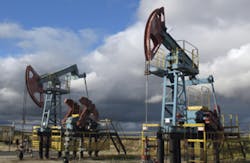Although enhanced oil recovery (EOR) currently accounts for merely 7.5 percent of total crude oil production in North America, the market is expected to grow rapidly as oil fields deplete and oil extraction becomes more complex, according to new analysis from Frost & Sullivan, "Strategic Analysis of North American Enhanced Oil Recovery Market."
Use of carbon dioxide EOR (CO2-EOR) will be more widespread than chemical or thermal EOR as federal governments focus on carbon capture and sequestration. While chemical EOR has not shown significant growth due to long pay out times and a longer breakeven point, using the right technique of injecting the chemical will help the method gain traction.
The new report finds that the EOR market earned revenues of $20.10 billion in 2014 and estimates this to reach $70.60 billion in 2020.
Frost & Sullivan says economic stability plays a significant role in EOR deployment. When the economy is slow, the decreased demand for oil lowers oil prices and curbs the adoption of EOR. EOR is profitable only when oil prices stand at $80 per barrel or above, as the capital and operational costs of the projects are very high.
“Economics also influence the selection of the type of EOR employed,” said Frost & Sullivan Energy and Power Industry Analyst Mahesh Radhakrishnan. “With governments turning their attention to carbon capture and storage, the number of CO2-EOR projects is expected [to] double by 2020. By 2025, 50 percent of the oil produced in the U.S. will be through EOR, of which 50 percent will be through CO2-EOR.”
READ ALSO: U.S. Chemistry Exports Linked to Shale Gas Could Double by 2030, New Report Shows
Despite the increasing number of CO2-EOR projects, overall production growth has been weak as a result of poor infrastructure to supply CO2, Frost & Sullivan says. Further, technology plays a very significant role in implementing new methods to extract oil from difficult environments such as oil sands or extra-heavy oil. The long time taken to design novel, fully functional technologies is holding back EOR.
“Ultimately, EOR will grow,” Radhakrishnan said. “Focusing on ultimate recovery rather than immediate recovery for short-term profit is necessary to keep depletion rates low and help companies exploit their reserves better. Emphasis on long-term strategies will also improve secondary oil recovery through sustainable development in the North American market.”
For more information on this research, visit http://bit.ly/NEBE-14.


